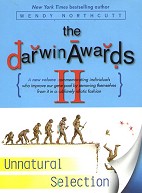Darwin Awards II
"Unnatural Selection"
C h a p t e r 7 S t o r i e s
Explosions: Out with a Bang!
|
||||
|
hypothesis (n) A tentative
explanation for an observation that can be tested by further
investigation. |
An older and more naive argument against evolution was that new species cannot arise from existing species. "The horse and the donkey are bred to form a mule, but the mule is sterile. A lion and a tiger produce the sterile liger. Therefore new species cannot arise from existing species." As explained in the discussion on speciation, page 190, no one supposes new species are combinations of old species, so this is an outmoded objection to evolution.
Critics of Darwinism have been increasingly hard-pressed to support their objections. Enter Intelligent Design Theory, or IDT. This "theory" was brought to light not in a reputable scientific journal, but rather by a self-described "intelligent design think tank" in Washington called The Discovery Institute. They argue that extremely complex systems, such as those with multiple interrelated parts like the lens and retina of the eye, or wings and feathers, could not have arisen spontaneously-and therefore must be the result of a supernaturally powerful designer.
After all, a watch doesn't repair itself.
Irreducible complexity is the cornerstone of IDT. They are referring to complexity too mind-boggling to have been created from infrequent random genetic mutations shaped by the pull of natural selection over billions of years -features that are obviously irreducibly complex and thus cannot have occurred without intelligent intervention.
At what point does one decide that a feature is irreducibly complex, proving that an unimaginably intelligent designer intervened? How do we know that human eyes, for example, are too complex to have evolved but for the intervention of an "intelligent designer"? Scientists can formulate persuasive explanations for the development of the eye, beginning as a light-sensitive patch of cells, but even the best attempt to explain any given complex system cannot disprove IDT.
The problem with the idea of irreducible complexity is that it is not testable. And the cornerstone of science is that a hypothesis must be testable in order to determine how well it fits the facts. Because there is no way to test IDT, it can never achieve acceptance as a scientific theory.
The idea of an intelligent designer is alluring to those who believe in a literal interpretation of theological texts. But IDT cannot compete with the theory of evolution, an explanation for the diversity of life that is supported by extensive probing from the scientific community, and the contents of a vast experimental knowledge base.
Because it is not testable, the latest version of creationism-Intelligent Design Theory-is anything but.
More on Intelligent Design Theory
|
Out with a Bang!
|
Fifteen Minutes of Flame
|
Author Bio Wendy
Northcutt holds a degree in molecular biology from UC Berkeley.
She began writing Darwin Awards in 1993, and founded the website soon
thereafter.
|
**Click this link to buy the book. I earn |
 |
|
Home |

 Discussion: Intelligent Design Theory
Discussion: Intelligent Design Theory